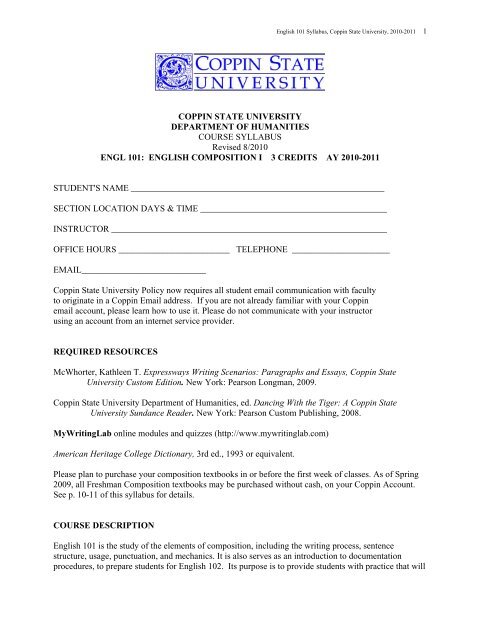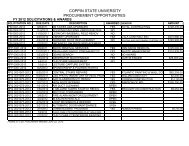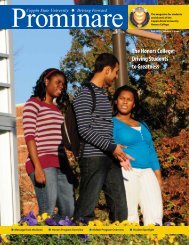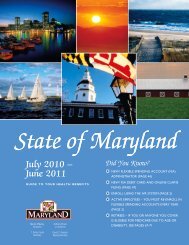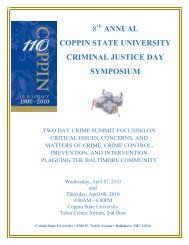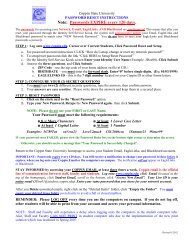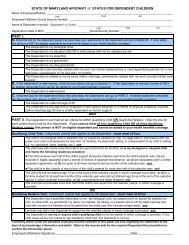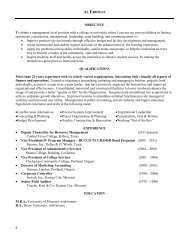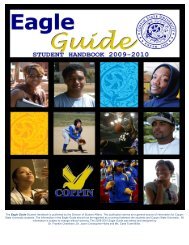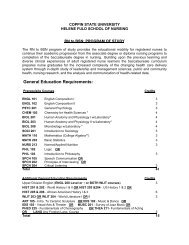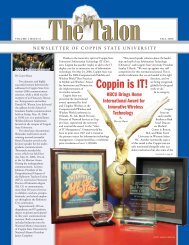English 101 - Coppin State University Homepage
English 101 - Coppin State University Homepage
English 101 - Coppin State University Homepage
Create successful ePaper yourself
Turn your PDF publications into a flip-book with our unique Google optimized e-Paper software.
<strong>English</strong> <strong>101</strong> Syllabus, <strong>Coppin</strong> <strong>State</strong> <strong>University</strong>, 2010-2011 1COPPIN STATE UNIVERSITYDEPARTMENT OF HUMANITIESCOURSE SYLLABUSRevised 8/2010ENGL <strong>101</strong>: ENGLISH COMPOSITION I 3 CREDITS AY 2010-2011STUDENT'S NAME _________________________________________________________SECTION LOCATION DAYS & TIME __________________________________________INSTRUCTOR ______________________________________________________________OFFICE HOURS _________________________ TELEPHONE ______________________EMAIL____________________________<strong>Coppin</strong> <strong>State</strong> <strong>University</strong> Policy now requires all student email communication with facultyto originate in a <strong>Coppin</strong> Email address. If you are not already familiar with your <strong>Coppin</strong>email account, please learn how to use it. Please do not communicate with your instructorusing an account from an internet service provider.REQUIRED RESOURCESMcWhorter, Kathleen T. Expressways Writing Scenarios: Paragraphs and Essays, <strong>Coppin</strong> <strong>State</strong><strong>University</strong> Custom Edition. New York: Pearson Longman, 2009.<strong>Coppin</strong> <strong>State</strong> <strong>University</strong> Department of Humanities, ed. Dancing With the Tiger: A <strong>Coppin</strong> <strong>State</strong><strong>University</strong> Sundance Reader. New York: Pearson Custom Publishing, 2008.MyWritingLab online modules and quizzes (http://www.mywritinglab.com)American Heritage College Dictionary, 3rd ed., 1993 or equivalent.Please plan to purchase your composition textbooks in or before the first week of classes. As of Spring2009, all Freshman Composition textbooks may be purchased without cash, on your <strong>Coppin</strong> Account.See p. 10-11 of this syllabus for details.COURSE DESCRIPTION<strong>English</strong> <strong>101</strong> is the study of the elements of composition, including the writing process, sentencestructure, usage, punctuation, and mechanics. It is also serves as an introduction to documentationprocedures, to prepare students for <strong>English</strong> 102. Its purpose is to provide students with practice that will
<strong>English</strong> <strong>101</strong> Syllabus, <strong>Coppin</strong> <strong>State</strong> <strong>University</strong>, 2010-2011 2help them to develop the ability to write clear expository prose in essays derived from critical readingand class discussions of selections from the reader or elsewhere.Important: All sections of <strong>English</strong> <strong>101</strong> are officially hybrid courses, utilizing both traditional andonline instructional modes. The online component for the course is supplied through tutorials andquizzes made available to us by Pearson Longman publishers at MyWritingLab.com. Use ofMyWritingLab is not optional for ENGL <strong>101</strong>; students must have access to the site, either bypurchasing a new copy of the required test or by purchasing online access without textbook purchase (ifthey use a used textbook, for example).By the second week of the semester, all <strong>101</strong> students should be enrolled in MyWritingLab, havecompleted the diagnostic, and be working with instructors on a plan to supplement classroominstruction with the resources of MyWritingLab.Instructors: you may assign student-specific MyWritingLab tutorials in place of, or in addition to,<strong>Coppin</strong> Learning Resource center hours, based on your assessment of student performance on the writtendiagnostic and/or the MyWritingLab diagnostic.COURSE OBJECTIVESAt the end of the course, students should be able to do the following:1. Focus on a purpose, select an essay topic, limit it to a length appropriate for the assignment, andrespond in an essay that is within the realm of personal experience, observations, or critical reading;2. Follow the writing process, including a) using various prewriting techniques, b) writing one or moredrafts, c) revising and editing, d) proofreading, and e) making an outline and using it as needed in thewriting process;3. Write sentences that a) conform to the conventions of standard <strong>English</strong> in usage, punctuation, andmechanics, including spelling; and b) take a variety of forms, employing such devices as coordination,subordination, and parallelism;4. Write unified, coherent, and adequately developed paragraphs with clearly expressed central ideas;5. Use conventions of format and structure appropriate to the rhetorical situation;6. Demonstrate in writing the ability to think analytically about personal experiences, observations orreadings and develop these ideas in a coherent essay;7. Demonstrate an understanding of how to cite summarized, paraphrased and quoted material used assupport in required essays and a basic understanding of MLA documentation format;8. Understand the uses of the dictionary and thesaurus, and use a dictionary to determine wordmeanings, parts of speech, etymologies, and possible usage problems; and9. Develop a portfolio that includes a 1) a cover letter in business letter format; 2) two essays, one fromeach of the two categories of rhetorical models specified below under "Determination of the FinalGrade," with at least one edited, graded draft of each; 3) two blue books for diagnostic purposes; oneblue book should be completed in the first week of classes and the other in the last two weeks of classes.
<strong>English</strong> <strong>101</strong> Syllabus, <strong>Coppin</strong> <strong>State</strong> <strong>University</strong>, 2010-2011 4F. Mid-Term portfolio due to instructors Monday, October 11 th , including onecarefully revised, edited, and proofread essay and Process paragraph/cover letter.Instructors must submit mid-term portfolios to FEC Committee by Tuesday,October 12 th at noon.Mid-term Grades Due Tuesday, October 19thUnit 5: Introduction to Advanced Rhetorical Models and Use of SourcesA. Selected readings from DWTTB. Chapter 17 "Summarizing and Synthesizing Sources," 394-420.C. Summarizing and Synthesizing exercises (see instructor’s manual 67-68).D. Essay 2: Instructors may choose to assign an essay on argument, cause and effect, 343-364;comparison/contrast (317-342); definition (299-316); or textual analysis (see p. 6,syllabus, for details).Unit 6 : Process Analysis and Portfolio Cover LetterA. Review Chapter 8 "Process Analysis,” (Exp), 238-257.B. Process Analysis cover letter for the portfolio. The cover letter should followbusiness letter formats (127-128, 228-229) and should address how each essay in theportfolio was composed and revised, as well as an assessment of each paper'sstrengths and weaknessesC. Editing and revision of Essay #2.Unit 7: Editing and Submission of PortfolioA. Revising, Proofreading and Preparation of Portfolios and Cover Letters.B. Final ConferencesC. Portfolios Due to Instructors no later than December 10 th , 2010. Instructors must submitportfolios to FEC Committee by no later than December 11 th , 2010 at noon.Final Instructor Grades Due: December 21 st , 2010.TECHNOLOGY USED IN THIS CLASSROOMAt the discretion of the instructor, power point, web-based resources, computer /word processingtutorials and/or audio-visual formats may be used. All sections will have full use of tutorials andquizzes at MyWritingLab.comAt least one assignment completed in this class will be submitted to Turnitin, an online originalityverification services.MODES OF INSTRUCTIONAs noted above, this is a hybrid course involving extensive use of online technology to enhance learningopportunities. In addition, the instructor is encouraged to vary classroom experience by the use oflectures as appropriate, class discussion, writing, revising, and editing activities, reading essays out loud,and small group activities.<strong>101</strong> BEST PRACTICES1. Students should be given opportunities to plan, revised, edit, and proofread all their writing.
<strong>English</strong> <strong>101</strong> Syllabus, <strong>Coppin</strong> <strong>State</strong> <strong>University</strong>, 2010-2011 52. Students should have frequent opportunities, beyond the three required essays and final exam, topractice writing that is not revised or graded, or which involves “low stakes” grading.3. Students should be given frequent opportunities to revise both graded and non-graded essays.4. Students should be encouraged to read and comment on the writing of other students, includingoffering suggestions for revision, editing, and proofreading one another’s work.TECHNOLOGY FLUENCYFinal drafts of all out-of-class assignments must be produced with a computer. Familiarity withMicrosoft Word 2003 or later, OpenOffice, Wordperfect, or another word processing program isimperative. Dependable access to the Web and to a computer is also required.WRITING CENTER/MYWRITINGLAB.COM REQUIREMENTStudents who need additional help with the writing process will be required to attendtutorial sessions and/or workshops at the Writing Center and/or complete assigned grammarmodules in MyWritingLab.com In order for students to have access to tutorials, they musthave a typed assignment from the instructor.MODES OF EVALUATIONStudents will be evaluated according to their performance on quizzes, tests, writing assignments, threerequired essays, the mid-term assessment, and the final portfolio. Instructors may include labassignments and Writing Center attendance as a component in the final grade. Instructors determine therelative weight of each assignment, except the final portfolio. The determination of grades for all dailywriting assignments is the individual instructor's. Instructors may consider not only the quality of thefinal draft but also the effort and attention given to the stages in the writing process. An excellent finaldraft will not necessarily be awarded a high grade if students have ignored instructions regarding prewriting,drafting and revision. A passing portfolio consists of all three papers at a grade level of 4 (“C”)or better.A “C” grade is defined according to the standards of the Maryland <strong>State</strong> System, as follows:A. ContentThe "C" paper fulfills the assignment, meeting all specified requirements, such as subject, organization,and length, and reflects the author's awareness of audience and purpose. The paper presents a centralidea supported by relevant material (facts, figures, examples, quotations, or other details). The reasoningis sound; arguments are supported with adequate evidence; and the paper makes appropriate use ofspecific, concrete, and relevant information. Other points of view are acknowledged and responded to asappropriate. Sources of information are accurately presented and fully attributed.B. OrganizationThe "C" paper has a discernible and logical plan. It has a focus, and the writer maintains the focusthroughout the essay. The writer has unified the entire essay in support of the central idea, or thesis, andindividual paragraphs in support of subordinate points. Some individual paragraphs, however, may beweak. The writer promotes coherence through the logical order of paragraphs and the use of some or allof the following devices: thesis statement, topic sentences, opening and closing paragraphs, and
<strong>English</strong> <strong>101</strong> Syllabus, <strong>Coppin</strong> <strong>State</strong> <strong>University</strong>, 2010-2011 7• A cover letter or MLA-formatted process narrative (500 + words) describing the contents ofthe portfolio and detailing the writer's experience and development in the writing process overthe course of the semester.• One or more graded drafts of each of the two essays and the cover letter / process narrative.If the portfolio fails, the student is required to repeat the course.FINAL GRADES AWARDEDThe grades given in <strong>English</strong> <strong>101</strong> are " A", "B", "C", "CS", "I”, and "F"."CS" means "continuing satisfactorily" --- that is, the student is making progress but needs moreinstruction at the <strong>English</strong> <strong>101</strong> level. A student whose writing is not yet up to standard but who attendsclass regularly, completes all assignments in a timely fashion, and fulfills all other course requirementswill receive the "CS" grade. Although "CS" is not a passing grade, it does not lower the grade pointaverage as does the "F". A "CS" grade may be assigned if the student satisfies all other courserequirements butfails the final exam.Students who have received a "CS" in <strong>English</strong> <strong>101</strong> two or more times must inform their instructorsimmediately. Repeaters will be referred to the Coordinator of Freshman <strong>English</strong> for additionalassistance in revising the portfolios."I" means "incomplete." An "incomplete" will be given only if a student who has been completingsatisfactorily all assignments has an end-of-term emergency which prevents completion of not morethan two final assignments. The student must discuss the situation with the instructor and provideverification of the emergency. The decision to give an "I” grade is the instructor's prerogative.Note: The “I” grade will not be given to students who satisfy all other course requirements but fail theportfolio. If students receive an "I" because they were unable to complete the portfolio they mustcomplete it by the end of the following semester or at least two weeks before the deadline for changing“I” grades. Failure to do so will result in the conversion of the "I" to an "F".ATTENDANCE POLICYRegular and punctual class attendance is required. Students who are late fifteen minutes for class will bemarked absent. Excessive lateness will affect the final grade.Students who are absent more than six class hours, whether the absences are excused or not, may fail thecourse. The class hour is equivalent to fifty minutes, which is not necessarily equivalent to a classmeeting or period.EXPECTATIONS FOR CLASSROOM BEHAVIOR1) All students are expected to listen to and respect the comments, analyses, and questions of others,regardless of whether they agree or not; wait their turns to make contributions; refrain fromconversations with classmates when the professor or another classmate is speaking;
<strong>English</strong> <strong>101</strong> Syllabus, <strong>Coppin</strong> <strong>State</strong> <strong>University</strong>, 2010-2011 82) Cell phones and pagers must be turned off in the classroom;3) College policy prohibits eating in classrooms;4) Students must not interrupt the class to leave the room for any reason other than an emergency. If theydo so, they may not return and will be marked absent.If a student engages in disrespectful conduct, the instructor reserves theright to ask that student to leave the classroom and will follow disciplinaryprocedures for such behavior as outlined in the Student Handbook (pp. 64-68).COLLEGE-WIDE WRITING POLICIESThe Department of Humanities and Media Arts adheres to the <strong>University</strong> of Maryland standards for a“C” paper and other <strong>University</strong> of Maryland composition standards.PLAGIARISM POLICYIt will be taken for granted that any work oral or written, that a student does for any course is his/heroriginal work. Any violation of this rule – including cutting and pasting from the internet withoutappropriate paraphrase or citation and documentation -- constitutes plagiarism.Plagiarism includes any form of cheating on examinations, tests, quizzes and any unacknowledged and/orundocumented use of another's writing or ideas published or unpublished. The minimum penalty forplagiarism is that the student will receive a failing grade for the particular assignment.FEC courses make use of the Turnitin online originality verification software.TEXTBOOK PURCHASESBy special arrangement, all Freshman Composition course textbooks may be charged to your studentaccount. The system works as follows:• A student who is enrolled in one of the Freshman Composition courses will simply go to thebookstore and pick up his/her textbook (with other books or not).• The bookstore staff knows of this arrangement. We have had several meetings with them. If theclerk doesn't seem knowledgeable - perhaps because they are a recent hire -- the student should askfor the textbook or store manager.• When they check out they need to identify this book(s) to the cashier and s/he will have the studentsign a log form acknowledging that they have gotten the text(s). This book(s) will be rung upseparately.• The log form will be posted next day to the student's bursar account charging him or her for the priceof the book including applicable tax. The signature will evidence the purchase for our records.• If there are problems - as there generally are with any new procedure - faculty should contact VPAFDick Siemer by phone or e-mail; students should talk with the textbook or store manager. Here arenames and numbers:o Charlie Ward Bookstore Mgr 410-951-1222o Tina Hughes Textbook Mgr 410-951-1222
<strong>English</strong> <strong>101</strong> Syllabus, <strong>Coppin</strong> <strong>State</strong> <strong>University</strong>, 2010-2011 9BIBLIOGRAPHYBailey, Edward P., and Philip A. Powell. The Practical Writing. 5th ed. New York: Harcourt, 1999.Barnet, Sylvan, and Marcia Stubbs and Pat Bellanca. The Practical Guide to Writing. 8th ed. NewYork: Longman, 2000.Dietsch, Betty Mattix. Reasoning and Writing Well. California: Mayfield, 2000.Kennedy, X.J., Dorothy M. Kennedy and Sylvia A. Holladay. The Bedford Guide for College Writers.Boston: St. Martin's, 1999.Marius, Richard. A Writer's Companion. 4th ed. New York: McGraw-Hill, 1999.Rackham, Jeff, and Olivia Bertagnolli. From Sight to Insight: The Writing Process. 6th ed. New York:Harcourt, 1999.Schwegler, Robert A. Patterns of Exposition. Boston: Longman, 2000.Wyrick, Jean. Steps to Writing Well. New York: Harcourt, 1999.


